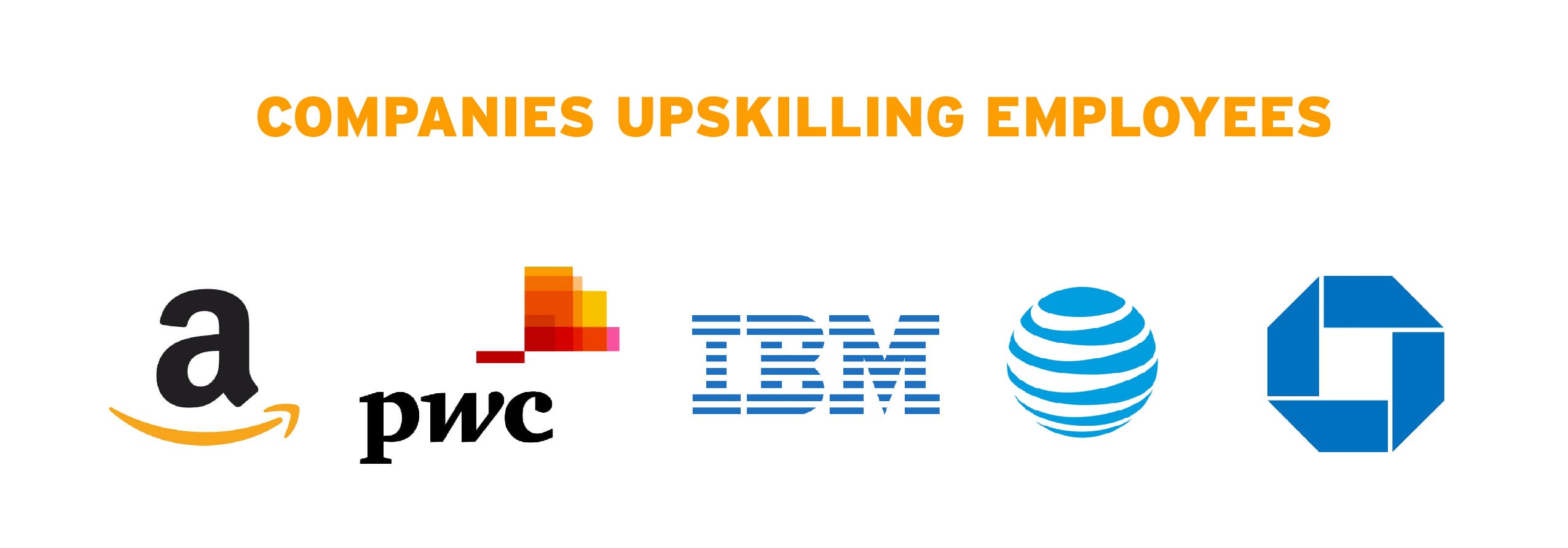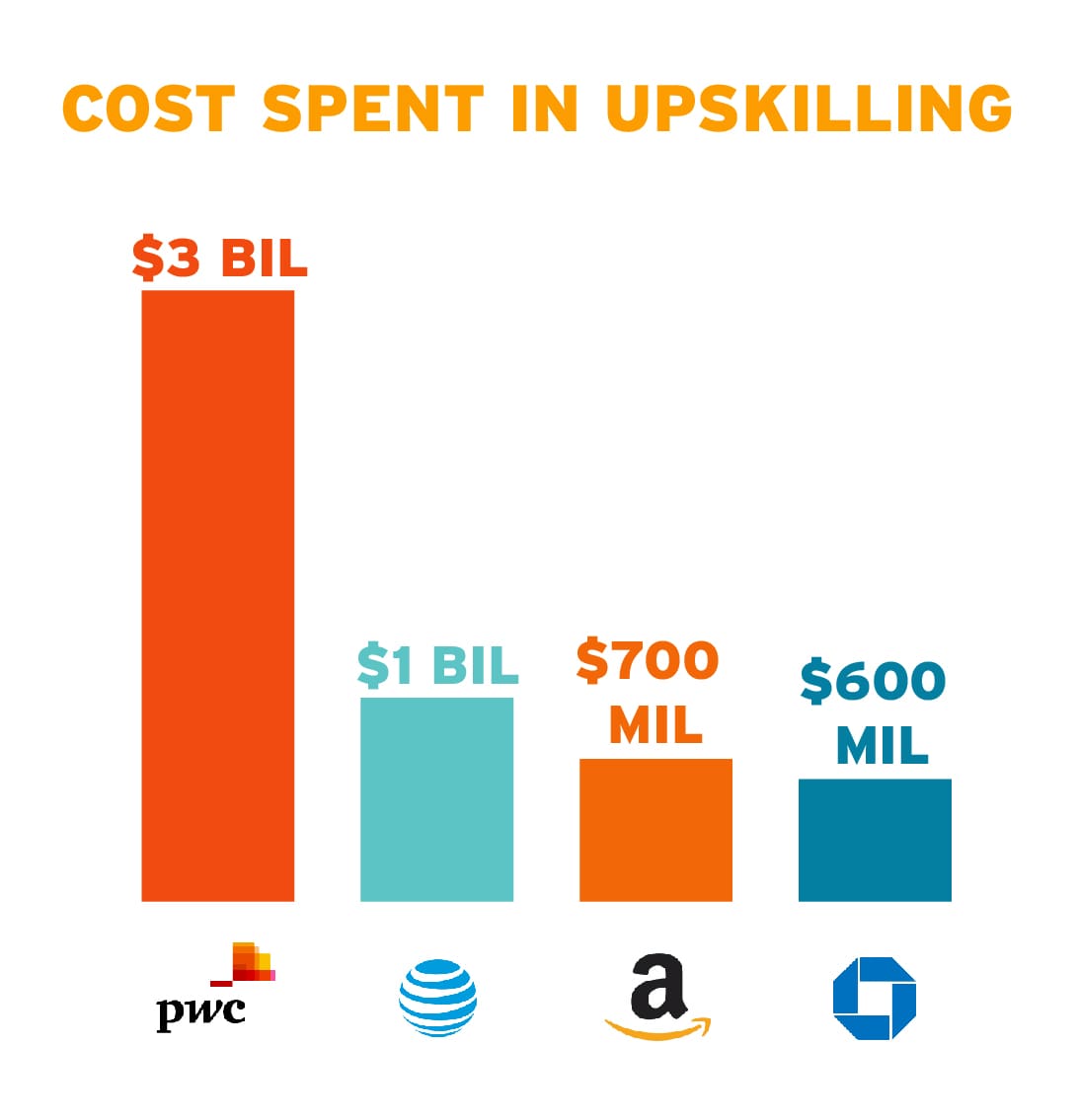CHROs: Here Are the Top Five Companies Investing in Upskilling in 2020
November 11, 2019 by Josh Hrala
Workers in the US and abroad are all facing one very important issue: the skills gap. Over the years, technological disruption and the threat of AI have loomed on the horizon, showing a need for workers to be prepared for the ‘future of work’ to fundamentally change.
While many researchers differ on just what the future of work will be and what repercussions workers will face in the long run, everyone seemingly agrees that now is the time to act.
This thinking has led many of the world’s biggest companies to start looking inward at their current workforce and coming up with ways to ‘upskill’ or ‘reskill’ their employees in hopes of retaining them.
This move has also likely been the byproduct of the US’s current labor market, which has been extremely tight throughout 2019 – a trend that appears to be continuing into 2020 as well.
You can read about the skills crisis in more detail here to get some background on the entire issue. Today, though, we will examine five of the biggest companies that have put their money where their mouth is when it comes to upskilling workers.
Kicking off the fifth spot, we have:
5. Amazon Plans to Upskill 100,000 Workers for Future Jobs
Amazon, the world’s largest online retailer, employs an absolute ton of workers. You have coders, business professionals, drivers, server technicians, fulfillment packers, and much, much more.
To retain this massive workforce, Amazon wants to upskill a large swath of their workers to be ready for the jobs that will be in-demand in 2025. While that seems like a far way off, technological disruption moves quickly, creating a need for Amazon to get out ahead of it, especially for workers who are currently in roles that are at risk for automation.
To do so, Amazon has pledged $700 million to offer workers across many of their departments access to training programs inside and outside the company.
These programs currently include six different options:
- Amazon Technical Academy, which will aid non-technical staff increase their tech literacy and potentially move into software engineering
- Associate2Tech, which hopes to help fulfillment center workers move into tech roles
- Machine Learning University, which helps those that already have a tech background move into the machine learning space, an area of work that has been taking off quite quickly over the last few years
- AmazonCareer Choice, another program for fulfillment workers to help them advance their careers and take on new roles that they enjoy
- Amazon Apprenticeship, a apprenticeship program that provides classroom training and on-the-job experience at the company. This program is certified by the Department of Labor
- AWS Training and Certification, a program that will help employees move into cloud computing roles, which have also become increasingly popular
As you can tell from this list, Amazon may have some plans to automate their fulfillment centers. This hasn’t been verified, but stands to reason. It’s nice to see that Amazon wants to retain those workers instead of simply laying them off, a practice that has pretty much been the standard operating procedure for countless companies over the years.
“Through our continued investment in local communities in more than 40 states across the country, we have created tens of thousands of jobs in the U.S. in the past year alone,” said Beth Galetti, Amazon’s Senior Vice President of HR in a release.
“For us, creating these opportunities is just the beginning. While many of our employees want to build their careers here, for others it might be a stepping stone to different aspirations. We think it’s important to invest in our employees, and to help them gain new skills and create more professional options for themselves.”
4. PwC Invests a Whopping $3 Billion to Upskill 275,000 Employees
The professional services company PricewaterhouseCooper, better known as PwC, recently announced that they too plan to upskill literally every employee that works for their company.
The plan, which was made public back in September, aims to provide training for 257,000 workers over the next four years, allotting $2,727- $3,636 for each employee, each year.
Bob Moritz, global chair for PwC, said that the investment will help the company become a ‘talent magnet,’ while also helping them retain current talent despite technological shifts that could render some jobs obsolete.
“If you opt in, OK, we will not leave you behind. I can’t guarantee you the specific job that you have or want to have. But I can guarantee you you’re going to have employment here,” Mortiz reportedly said, according to Business Insider.
The company said that the $3 billion will be used to get employees back into the classroom, develop digital training tools, lead community projects, and to work with large organizations like the United Nations and others to help them upskill workers across the world and in different cultures.
So far, PwC seems to be the front-runner when it comes to downright investment figures. Their $3 billion pledge towers over Amazon’s and every other initiative reported currently. PwC has also said, in many different ways, that this move is meant to help people not only work in the future but to alleviate the stress of an uncertain future. too.
3. IBM Is Using AI to Defeat the Jobs Killed by AI
If there is any company on the planet that knows the power of artificial intelligence, it’s IBM. The company has been pioneering the technology for years now. And, likely because of that, they are well aware that this technology will fundamentally kill off certain jobs and jeopardize others.
So, to help curb all of that, IBM has decided to turn to AI to help them identify upskilling strategies to defeat the jobs that will be turned redundant by AI.
“IBM introduced its SkillsBuild platform in France in May 2019 with the goal of identifying job skills and employment opportunities for members of disadvantaged communities,” reports CNBC.
“It will be rolled out in Germany in the coming months, followed by India, and then IBM plans to bring the platform to the U.S. in 2020, by which time it is likely that the program will have thousands of users, the company says.”
This program, in short, will do a bunch of different things from helping those who have a history of long-term unemployment (refugees, asylum seekers, veterans, etc) get personalized coaching and learning to enter the current and future workforce. IBM calls these new jobs ‘New Collar’ work, which is an interesting turn of phrase that strikes how work will ultimately change in the future.
“We’re using AI to identify exceptional people from all walks of life that have remarkable ability to actually be very rapidly retrained to not just be good engineers but the very highest-performing, most successful engineers in the industry,” said Jacob Hsu, CEO of Catalyte, at CNBC’s Capital Exchange Summit.
“So we’re literally hiring truck drivers and teachers, retail workers and fast-food workers … and very rapidly, within 20 weeks, getting them through a computer science degree and getting them into not just actual jobs but proving they can be highest performers in those roles.”
Besides hiring these oft-forgotten workers, IBM claims that AI will change every single job over the next decade. To combat this, IBM has basically taken up the mantle of upskilling hero by trying to warn the entire working world of what may happen if they do not upskill or reskill their workers.
For example, they have written a ton of different articles and have also commissioned many studies to help provide free information to business leaders the world over.
While their latest hiring push is more aligned with helping those in need, IBM makes this list for their sheer amount of effort and determination to upskill the planet for the coming ‘Fourth Industrial Revolution.’
2. AT&T Started Upskilling Way Back in 2008
AT&T started as a simple telephone company 133 years ago. With such a long history, it’s understandable that the company has shifted and pivoted countless times to keep up with the modern world.
But one of the biggest shifts happened in 2008 when AT&T found out that only half of their 250,000 workers had the proper skills relating to science, technology, and engineering to keep up with the current rate of change. They also found out that a huge portion of their workforce, around 100,000 workers, held jobs dealing with hardware, which would be rendered obsolete within the next decade, reports CNBC.
That’s a scary, huge number of workers that are not prepared for the future. For IBM, this gave them two options that any tech company, especially one that has been around for such a long time, has: do you lay off workers and hire new ones that fill these new demands or do you reskill your current workforce?
It’s obvious what they chose. They would take their existing workforce, retain them, and make them future-proof.
“Known inside the company as Future Ready, the initiative is a $1 billion web-based, multiyear effort that includes online courses; collaborations with Coursera, Udacity and leading universities; and a career center that allows employees to identify and train for the kinds of jobs the company needs today and down the road,” reports Susan Caminiti for CNBC.
“An online portal called Career Intelligence lets workers see what jobs are available, the skills required for each, the potential salary range and whether that particular area is projected to grow or shrink in the years ahead. In short, it gives them a road map to get from where they are today to where the company needs them to be in the future.”
What’s interesting about this method is that it’s a good example of what smaller companies can do, too. Udemy, Coursera, and other online platforms are available to everyone – even users who are not backed by a company.
These platforms are a great way to stay sharp and learn new skills. AT&T simply ran with these ideas as far as they could. In the end, AT&T hopes to reskill upwards of 100,000 employees, though this program seems like something that will continually be updated to help further future-proof them marching forward.
1. JPMorgan Chase Added $350 Million to Their Previous $250 Million Reskilling Plan
Back in March, financial firm JPMorgan Chase announced that they will add an additional $350 million to a preexisting $250 million plan to upskill their workforce.
The plan, called New Skills at Work, aims to do sort of the same thing that IBM is doing with their AI technology: upskill workers who are historically held back while also nailing down what emerging skill sets workers from all walks of life need to be competitive in the future.
“The new world of work is about skills, not necessarily degrees. Unfortunately, too many people are stuck in low-skill jobs that have no future and too many businesses cannot find the skilled workers they need,” said the company’s CEO and Chairman Jamie Dimon, according to MarketWatch.
“We must remove the stigma of a community college and career education, look for opportunities to upskill or reskill workers, and give those who have been left behind the chance to compete for well-paying careers today and tomorrow.”
JPMorgan Chase says that they will divide this huge sum of money into different parts with $200 million going to help prepare people for the future of work by creating programs that help train people for new, in-demand tech jobs.
$125 million will be used to improve existing training courses through community colleges, bringing educators and employers closer together.
Finally, $25 million will be spent on research to understand the current and future labor market to better prepare the company and their employees for the future. After all, you can’t train people for a future that you, yourself, don’t understand.
Again, this is very similar to the approach taken by IBM. Both companies are using a data-driven approach to reskilling and both have focused on under-served communities who will be hit even harder by the coming tech disruption and job changes. To that end, the company has even partnered with educational institutions such as MIT to reach their goals.
The Takeaways
All in all, many of the worlds top companies have all come to the same conclusion: the future of work is scary and daunting for workers. Many believe that they already lack specific skills to do their current roles or do not have the means to obtain the training needed to make them viable candidates in the future.
To that end, these companies have also taken the same approach: retain instead of rehire. There’s an obvious business case here, too. Hiring new people incurs a lot of cost, which could be saved by allowing current workforces to get the training they need. Also, it’s nice to see juggernaut-sized companies investing in their people. Years ago, rehiring would seem like the only option, but today that changed almost as much as the future of work itself.
Going forward, it will be interesting to see how other companies follow suit. With so many large firms leading the charge, it stands to reason that other, smaller companies will do the same, though it will be a lot harder to hear about all of the innovation that happens at that level.
More from Careerminds
In need of outplacement assistance?
At Careerminds, we care about people first. That’s why we offer personalized talent management solutions for every level at lower costs, globally.





